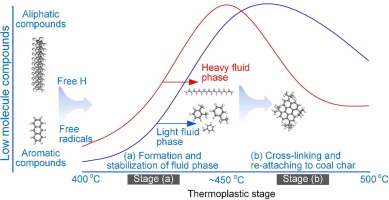Our official English website, www.x-mol.net, welcomes your
feedback! (Note: you will need to create a separate account there.)
Structural transformation of fluid phase extracted from coal matrix during thermoplastic stage of coal pyrolysis
Fuel ( IF 6.7 ) Pub Date : 2018-11-01 , DOI: 10.1016/j.fuel.2018.05.136 Shuxing Qiu , Shengfu Zhang , Yue Wu , Guibao Qiu , Chenggong Sun , Qingyun Zhang , Jie Dang , Liangying Wen , Meilong Hu , Jian Xu , Rongjin Zhu , Chenguang Bai
Fuel ( IF 6.7 ) Pub Date : 2018-11-01 , DOI: 10.1016/j.fuel.2018.05.136 Shuxing Qiu , Shengfu Zhang , Yue Wu , Guibao Qiu , Chenggong Sun , Qingyun Zhang , Jie Dang , Liangying Wen , Meilong Hu , Jian Xu , Rongjin Zhu , Chenguang Bai

|
Abstract Two-stage solvent extraction, involving acetone (light extraction) and tetrahydrofuran (heavy extraction), was used to obtain materials from the fluid component of the coal matrix during the thermoplastic stage of pyrolysis. These extracted materials were characterized using Laser desorption ionization time of flight mass spectrometry, Gas chromatography-mass spectrometer, 1H nuclear magnetic resonance and Fourier transform infrared spectroscopy. After identifying the different chemical compounds using the type difference technique, their structural transformation behaviour was considered. Results show that the molecular weight distribution of extracted materials was within 576 Da. Fluid phase obtained from the extract contained aromatic (benzene with alkyl) and aliphatic (long-chain unbranched alkanes) components. The quantity of these two materials increased as pyrolysis temperature increased from 400 to ∼450 °C, and then decreased with further increases in temperature from 450 to 500 °C. The overall structural transformation of the fluid phase in thermoplastic stage could be divided into two stages: (a) formation and stabilization of the fluid phase, and (b) the cross-linking and re-attaching of the fluid phase to coal char. In the temperature range of 400 to ∼450 °C, the level of both light and heavy fluid phases increased because of the combination of free radicals with hydrogen formed from the cracking of the coal matrix – resulting in shortening of the aliphatic chain length and improving generation of hydrocarbon in the extract. At higher temperatures, the cross-linking and preferential re-attaching of materials to the coal char caused a decrease in the fluid phase level. In turn, this resulted in the lengthening of the aliphatic chains, which weakened their hydrocarbon-generating potential. These two stages explain the transient behaviour of the fluid phase generated in the thermoplastic stage, and contribute toward a better understanding of the softening and solidification behavior of coal during coking.
中文翻译:

煤热解热塑性阶段从煤基质中提取的流体相的结构转变
摘要 两阶段溶剂萃取,包括丙酮(轻萃取)和四氢呋喃(重萃取),用于在热解的热塑性阶段从煤基质的流体组分中获取材料。这些提取的材料使用激光解吸电离飞行时间质谱、气相色谱-质谱、1H 核磁共振和傅里叶变换红外光谱进行表征。在使用类型差异技术识别不同的化合物后,考虑了它们的结构转变行为。结果表明,提取物的分子量分布在576 Da以内。从提取物中获得的流体相包含芳香族(带有烷基的苯)和脂肪族(长链直链烷烃)组分。这两种材料的数量随着热解温度从 400°C 增加到~450°C 增加,然后随着温度从 450°C 进一步增加到 500°C 而减少。热塑性阶段流体相的整体结构转变可分为两个阶段:(a)流体相的形成和稳定,以及(b)流体相交联和重新附着到煤焦上。在 400 到 450 °C 的温度范围内,由于自由基与煤基体裂解形成的氢结合,轻、重流体相的含量增加——导致脂肪链长度缩短并改善提取物中生成烃。在更高的温度下,材料与煤焦的交联和优先重新附着导致流体相水平降低。反过来,这导致脂肪链加长,削弱了它们的生烃潜力。这两个阶段解释了在热塑性阶段产生的流体相的瞬态行为,有助于更好地了解焦化过程中煤的软化和凝固行为。
更新日期:2018-11-01
中文翻译:

煤热解热塑性阶段从煤基质中提取的流体相的结构转变
摘要 两阶段溶剂萃取,包括丙酮(轻萃取)和四氢呋喃(重萃取),用于在热解的热塑性阶段从煤基质的流体组分中获取材料。这些提取的材料使用激光解吸电离飞行时间质谱、气相色谱-质谱、1H 核磁共振和傅里叶变换红外光谱进行表征。在使用类型差异技术识别不同的化合物后,考虑了它们的结构转变行为。结果表明,提取物的分子量分布在576 Da以内。从提取物中获得的流体相包含芳香族(带有烷基的苯)和脂肪族(长链直链烷烃)组分。这两种材料的数量随着热解温度从 400°C 增加到~450°C 增加,然后随着温度从 450°C 进一步增加到 500°C 而减少。热塑性阶段流体相的整体结构转变可分为两个阶段:(a)流体相的形成和稳定,以及(b)流体相交联和重新附着到煤焦上。在 400 到 450 °C 的温度范围内,由于自由基与煤基体裂解形成的氢结合,轻、重流体相的含量增加——导致脂肪链长度缩短并改善提取物中生成烃。在更高的温度下,材料与煤焦的交联和优先重新附着导致流体相水平降低。反过来,这导致脂肪链加长,削弱了它们的生烃潜力。这两个阶段解释了在热塑性阶段产生的流体相的瞬态行为,有助于更好地了解焦化过程中煤的软化和凝固行为。











































 京公网安备 11010802027423号
京公网安备 11010802027423号